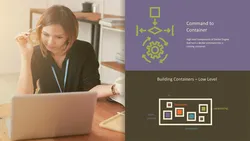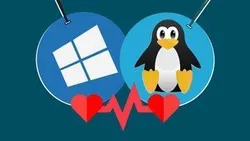
Just Enough Docker to be Dangerous 
This course provides an introduction to the basics of containers and Docker, allowing learners to gain hands-on experience and become comfortable with the technology. Through practical exercises, participants will gain the knowledge necessary to use Docker effectively. ▼
ADVERTISEMENT
Course Feature
![]() Cost:
Cost:
Free
![]() Provider:
Provider:
Udemy
![]() Certificate:
Certificate:
Paid Certification
![]() Language:
Language:
English
![]() Start Date:
Start Date:
On-Demand
Course Overview
❗The content presented here is sourced directly from Udemy platform. For comprehensive course details, including enrollment information, simply click on the 'Go to class' link on our website.
Updated in [February 21st, 2023]
Unlock the Exciting World of Learning! Here's What Awaits You:
This course will help you understand the basics of containers and docker, and how to use them to deliver software. You will learn the technologies under the hood of containers such as namespaces, cgroups, and union file systems. You will also learn how to setup a docker environment, launch containers, run and operate them, and understand port mappings. You will also learn how to use docker compose to launch a stack of interconnected services, and the basics of building images and writing a dockerfile. By the end of the course, you will have the skills and knowledge to confidently use docker to deliver software.
[Applications]
After this course, participants can apply their knowledge of Docker to build and deploy applications in a containerized environment. They can use Docker Compose to launch a stack of interconnected services, and use Dockerfiles to build images. Participants can also use their understanding of namespaces, cgroups, and union file systems to better manage their containers. Additionally, they can use their knowledge of port mappings to better understand how their applications interact with the outside world.
[Career Paths]
1. Container Engineer: Container Engineers are responsible for designing, building, and maintaining container-based applications. They must have a deep understanding of container technologies such as Docker, Kubernetes, and OpenShift, as well as the underlying infrastructure. They must also be able to troubleshoot and debug container-based applications. This is a rapidly growing field, as more and more companies are adopting container-based technologies.
2. DevOps Engineer: DevOps Engineers are responsible for automating the deployment, monitoring, and maintenance of container-based applications. They must have a deep understanding of container technologies, as well as the underlying infrastructure. They must also be able to troubleshoot and debug container-based applications. This is a rapidly growing field, as more and more companies are adopting container-based technologies.
3. Cloud Architect: Cloud Architects are responsible for designing and implementing cloud-based solutions. They must have a deep understanding of container technologies, as well as the underlying infrastructure. They must also be able to troubleshoot and debug container-based applications. This is a rapidly growing field, as more and more companies are adopting container-based technologies.
4. Security Engineer: Security Engineers are responsible for ensuring the security of container-based applications. They must have a deep understanding of container technologies, as well as the underlying infrastructure. They must also be able to troubleshoot and debug container-based applications. This is a rapidly growing field, as more and more companies are adopting container-based technologies.
[Education Paths]
1. Bachelor of Science in Computer Science: This degree path focuses on the fundamentals of computer science, such as programming, software engineering, and computer architecture. It also covers topics such as artificial intelligence, machine learning, and data science. With the increasing demand for software development and the rise of container-based technologies, this degree path is becoming increasingly popular.
2. Bachelor of Science in Information Technology: This degree path focuses on the application of technology to solve business problems. It covers topics such as network security, database management, and web development. With the increasing demand for software development and the rise of container-based technologies, this degree path is becoming increasingly popular.
3. Master of Science in Computer Science: This degree path focuses on advanced topics in computer science, such as distributed systems, computer networks, and software engineering. It also covers topics such as artificial intelligence, machine learning, and data science. With the increasing demand for software development and the rise of container-based technologies, this degree path is becoming increasingly popular.
4. Master of Science in Information Technology: This degree path focuses on the application of technology to solve business problems. It covers topics such as network security, database management, and web development. With the increasing demand for software development and the rise of container-based technologies, this degree path is becoming increasingly popular.
Pros & Cons

Good training

Fills gaps in knowledge

Fast paced and useful content

Provides terminology

Training does not flow great

Confusing to begin with

Not for level1 beginners

Needs prior reading of official documentation
Course Provider

Provider Udemy's Stats at AZClass
Discussion and Reviews
0.0 (Based on 0 reviews)
Explore Similar Online Courses

Grinding Noise: Is There a Problem with My Brakes?

Create promote and monetize your blog Full Course Wix Learn

Python for Informatics: Exploring Information

Social Network Analysis

Introduction to Systematic Review and Meta-Analysis

The Analytics Edge

DCO042 - Python For Informatics

Causal Diagrams: Draw Your Assumptions Before Your Conclusions

Whole genome sequencing of bacterial genomes - tools and applications

Managing Docker on Linux Servers

Fundamentals of Docker and Kubernetes for NET Developers


Start your review of Just Enough Docker to be Dangerous